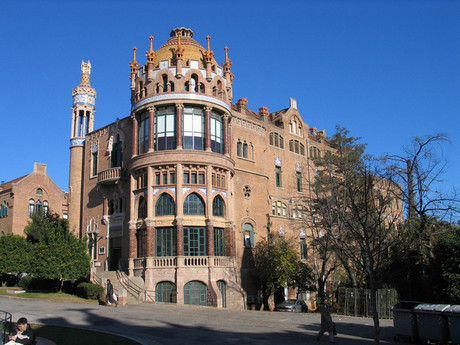Hospital de Sant Pau
The present Hospital de la Santa Creu i Sant Pau in the neighborhood of El Guinardó, Barcelona, Catalonia (Spain), is a complex built between 1901 and 1930, designed by the Catalan modernist architect Lluís Domènech i Montaner. Together with Palau de la Música Catalana, it is a UNESCO World Heritage Site. It was a fully functioning hospital until June 2009, it is currently undergoing restoration for use as a museum and cultural center. As of December 2009 there are still tours of the hospital being given several times a day.
Although the hospital's current buildings date from the 20th century, the Hospital de Sant Pau was founded in 1401 when six small medieval hospitals merged. The hospital's former buildings near the center of Barcelona date from the 15th century, and now house an art school (Escola Massana) and Biblioteca de Catalunya (National Library of Catalonia). Even though there is an ambulance in the picture, which appears to be a Ford Transit, it is not a hospital anymore as it was closed down in 2009.
The Hospital de la Santa Creu i Sant Pau dates back to 1401 when six hospitals in the city merged, forming the Hospital de la Santa Creu. With the growth of the city and the advances in medicine in the 19th century, the centre was unable to meet the demands of the time and construction of a new building was proposed.
Thanks to the legacy of Pau Gil, a banker, on January 15, 1902 the first stone of the new building was laid. “Sant Pau” was added to the old name of “la Santa Creu” to honour the wishes of its benefactor. The architect Lluís Domènech i Montaner was commissioned with the project. Over the years, the Hospital de la Santa Creu i Sant Pau has become the most significant public building in Catalan modernisme.
In 2001 the Hospital de la Santa Creu i Sant Pau celebrated its 600th anniversary. Since it was first founded in 1401 it has undergone constant development. Its original mission – “to serve the poor and pilgrims according to Christian Charity” – has evolved to needs of today, “to be a community-based, patient-focused reference centre”.
A hospital is not the typical image that comes to mind when one thinks of architectural wonders. Hospital de Sant Pau will make you think twice about the different types of structures that can be considered beautiful. Hospital de Sant Pau is considered one of the most beautiful hospital complexes on earth featuring lush gardens filled with trees and flowers, exposed brick facades, polychrome tile, sylvan paintings, and brightly colored mosaics throughout as well as sculptures by Pau Gargallo. The therapeutic power of design and color laid the foundation for the stunning design and color scheme of Hospital de Sant Pau. Free tours are available daily and on weekends (by reservation).
The Hospital de Santa Creu i de Sant Pau is in the northern part of Barcelona in the district of the Eixample. The old hospital in El Raval in which Gaudí died in 1926 is nowadays the home of the medical faculty and the Catalan State Library. In Eixample man can find lots of hotels. Don't forget to book a reservation in the area. The district is famous for its modernist architecture and notable places worth traveling and sightseeing.
With the construction of the hospital from 1902 to 1912, the architect Lluís Domènech i Montaner achieved a masterpiece – a specially human and in no way sterile building that nonetheless met the highest medical standards. The hospital takes up one whole block, and the almost 30 buildings are situated in a park. The different pavilions have subterranean connections.
When stepping through the main entrance into the area of the Hospital de Santa Creu I Sant Pau, you come into the chapel-like administration building with a large dome roof in the impressive entrance hall. It is not a coincidence that the building resembles a church – it is to symbolize the Christian tradition.
Behind the administration building, you see the pavilion with the operation rooms. This pavilion is connected to all other pavilions via a tunnel system so that patients can quickly be transferred to their rooms. The operation rooms are located below the three glass apses on the northern side of the pavilion.
At the end of the original area is the cloister pavilion. It was designed by Pere Domènech, the son of Lluis Domènech i Montaner. It consists of three parts, connected via small roofed pedestrian bridges. It contains the service areas of the hospital such as the kitchen, pharmacy and the sleeping quarters of the nuns working as nurses here.
A new construction, situated behind the cloister building, enhanced the old hospital. You can get to the hospital de Santa Creu i de Sant Pau coming from the Sagrada Familia via the newly designed and embellished Avinguda de Gaudí or from the metro station Hospital de Sant Pau. Guided tours are offered after prior booking. The hospital is part of the Gaudi's testament and an absolute must-see whien you travel to Barcelona. Gaudi's masterpieces are included in every tour guide across the city and are well worth the time spent for sightseeing.The park is a beautiful place to rest. You can get there via direct flight to Barcelona or to Girona, Reus or Lleida–Alguaire.




